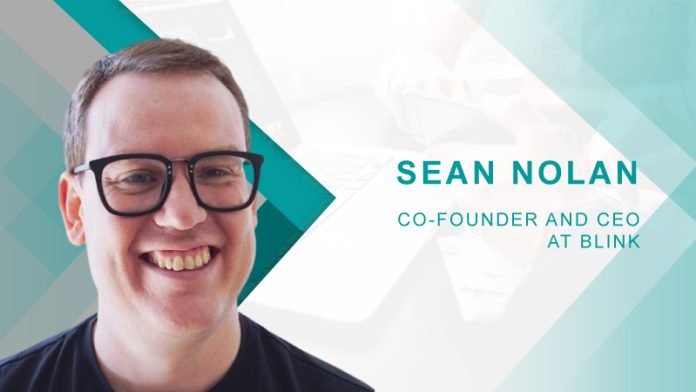Sean, please tell our readers the idea behind the inception of Blink.
I came up with the idea for Blink whilst working at my former company. It was a large organization with a lot of remote workers and we struggled to create a culture where everyone felt involved and connected, but we also struggled with manual processes which were inefficient and frustrating for everyone!
I made it my mission to find a solution to this issue and improve the remote employee experience, but what I quickly learned was that most employees weren’t interested in one way comms or increasing ‘engagement’. What these employees wanted were tools that made their life easier and empowered them to get stuff done in a simpler way.
This was how Blink was founded. After a lot of development and a few stumbles along the way, we secured our first major client win with Stagecoach in 2019, 24,000 transit workers, which really validated our vision. After integrating Blink into its workforce, the results for Stagecoach were impressive: a 46% surge in employee satisfaction and a 26% reduction in staff turnover.
Today, Blink serves more than 300 companies globally at companies like Domino’s, Tonkotsu, Saint Luke’s Hospital, Elara Caring, and Falck Ambulance.
How has technology contributed in facilitating key internal conversations, and what broader impacts can we anticipate in terms of how people interact and collaborate within organizations?
Technology is the key to creating a connected and committed workforce, but only if it is truly accessible to everyone within an organization – not just those who sit down in front of a computer each day.
Everyone – be it nurses, bus drivers or retail assistants – use digital technology everyday in their personal lives for shopping, social media, keeping in touch with friends, managing their finances, and listening to their favorite audiobooks. But the second they step into their uniforms and clock into work, they become digitally disconnected because the technology at work has been built for desk-based workers.
Blink is changing this by taking the consumer-tech experience and bringing it into the workplace across mobile and desktop. We offer different modes of interaction, depending on the context and people’s preferences – from a news feed, comments, private chats, semi-public channels, feedback forums and affinity groups – whilst keeping it simple and intuitive.
For example, we find frontline workers really value having a direct, secure 1-2-1 chat with their manager, where they are often more comfortable discussing things than they might be in person. Likewise, one of our clients set up a ‘gratitude’ channel where employees give each other kudos and recognition in a way that just wasn’t possible before. It has fast become one of the most popular chats within their organization and makes remote workers feel seen and valued on a daily basis.
One of the most popular types of content is leadership posts on the news feed – the more authentic and unpolished the better – people really value that direct connection, without the corporate shine. It can help everyone feel more connected and build trust.
The use of employee engagement apps has been noted for bridging the gap between leadership teams and staff. How has this dynamic contributed to creating a trusting atmosphere within organizations?
A key element of this is transparency – today, people want more authentic and less filtered information. They like a tone of voice and format that transcends the corporate hierarchy and feels more like two people connecting as we would in person. So, leaders that master regular sharing of photos, unedited video updates and the context and rationale behind their decisions, are the leaders that are building trust and engagement quickly.
We also encourage customers to open up comments as much as possible – this can be uncomfortable as not all comments are positive, but actually leaders are often surprised by how positive the tone is and how often peers will jump-in to address any negative comments.
How do front-line employees perceive the impact of technological initiatives on their work environment? In what ways do they feel valued, and how does it influence their motivation to do good work?
When we start working with a new frontline team, they often already feel overwhelmed with the number of channels and apps they are being asked to use. This is why we get involved – we simplify the experience. There is often an initial distrust of the technology – especially when our app goes on to their personal smartphone most of the time – so we have various ways to overcome this and get to our benchmark of a 90% adoption rate.
We are very sensitive to not making people feel like they are being tracked, like their personal data is being used, or that we’re going to interrupt them outside of work, or while they are performing a critical duty.
We’ve also invested heavily in the on-boarding process, as this is one of the key blockers to frontline workers wanting to use enterprise technology.
How do you see the relationship between employee engagement apps, internal communications, and the establishment of trust within teams?
For frontline organizations, the only effective way to tackle this area is to holistically look at the entire digital employee experience, and the digital operational needs of the business. Together, these need to be combined into a simple, frictionless experience that incorporates all the key elements such as communication and engagement but is also extendable for any future requirement. For workers, when we bring all these elements together in one app and demonstrate we have created a tool that is there to make their lives easier, only then do they start to really lean in to using it every day – and that is how we start to really build their trust.
How can organizations measure the success of tech-driven initiatives in enhancing internal communication, collaboration, and overall employee engagement?
The ultimate measure of success is employee turnover and employee satisfaction. We measure both metrics in real time, with the data broken down by manager, location, role and much more. We also measure a number of contributing factors, such as engagement with content, sentiment, utilization of benefits and the frequency of communication within teams and with managers. We’re able to offer a true 360-degree view of the organization in a way that hasn’t been possible before, including actionable insights to improve employee engagement.
While technologies offer significant benefits, are there challenges that organizations commonly face in implementing and maximizing the potential of employee engagement apps? What opportunities do you see for further improvement in this space?
The biggest challenge I see in this space is organizations trying to implement tech tools that aren’t designed with frontline employees in mind. To close this all-too-common digital divide, it’s crucial they work with technologies specifically designed for team members that are on-the-go. For example, offering single sign-on, mobile-enabled access to all applications will greatly improve accessibility. A content hub can make it easy for all workers to access important information. Simple mobile forms can replace paper trails and help workers improve efficiency, as well as eradicate convoluted IT support tickets so that workers are not put off asking for assistance.
And then crucially, leadership teams must ensure they are checking in with their frontline teams regularly for feedback on the use of these tools. Understanding what works and what isn’t allows for continual improvement and adaptation – ultimately leading to greater adoption amongst their employees.
What trends do you foresee in the realm of internal communication, particularly with the integration of technology? How might these trends further shape the dynamics of employee engagement and collaboration?
We’ve already been able to achieve a level of personalization most organizations have never experienced before – content targeted by time, location, role, skills, language and much more. This will become the norm over the coming years. We’re also seeing the rise of consumer style interfaces – people are spending more time on apps like TikTok and we’re already working with customers to bring this style of feed into the workplace.
Companies are also looking to encourage more user-generated, authentic content that gives everyone a voice and helps the best stories spread far and wide, inspiring the whole organization.
Of course, we’re seeing every element of the employee experience enriched with AI – content creation, on-boarding journeys, training, self-service chat bots, Q&A interfaces to name just a few.
What advice would you offer to organizations aiming to enhance their internal communication strategies through the use of technology and employee engagement apps?
I advise them to come talk to us! We can share what we’ve seen work and what doesn’t work. I’d advise against trying to tackle just communication, or just benefits, or just surveys, in isolation. Step back and look at the entire digital employee experience. It’s much easier to get started than you might think but start with building something genuinely useful to your people, and something that integrates with your existing technology.
How do you envision the continued evolution of technology’s role in internal communication, and what positive outcomes can organizations expect as they continue to leverage these tools to foster collaboration and engagement within their teams?
You’re going to see a lot of focus on simplification. Organizations will be asking: how can we remove old and ineffectual channels and focus on a mobile-first approach, augmented with AI, but in a familiar consumer-style experience? You’re going to see culture change starting from the bottom-up more as frontline workers continue to grow a larger voice. This is going to drive a dramatic improvement in business outcomes, customer satisfaction and operational performance. Most of all – it’s going to feel much better to be part of a connected organization – it’s fun, it’s engaging and you’ll be part of a winning team.
Explore HRtech News for the latest Tech Trends in Human Resources Technology.

Sean Nolan Co-Founder and CEO at Blink
Driven by his early encounters with remote work challenges, Boston-based CEO Sean Nolan co-founded Blink in 2014. This all-in-one "super-app" empowers frontline workers with the digital tools, connections, and resources they need on their personal phones. Blink bridges the gap between management and millions of individuals across industries, from bus drivers to healthcare workers, fostering engagement, belonging, and a 26% reduction in staff turnover. With over 300 clients, and used seven times daily by 300,000+ workers, Blink is revolutionizing the frontline experience, one tap at a time.













